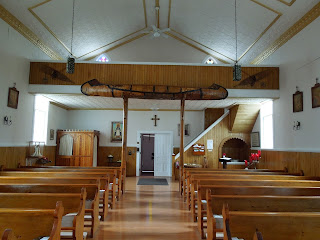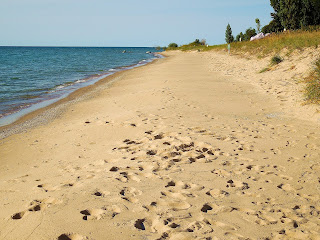Recently, we stayed at a B&B in Mackinaw City, Michigan (USA). We were having breakfast with a couple from northern Illinois. Later in the week, they were planning to go to Traverse City and driving the Lake Michigan coastline south on their way home. Since they weren't familiar with the Emmet County area, they asked us if there was something they "must see". So, we gave the obvious answer - "you should drive M-119".
In 2003, M-119 was officially designated a state Scenic Heritage Road (aka Pure Michigan Byway). According to Wikipedia, this designation is given to "a scenic, recreational, or historic route that is representative of Michigan's natural and cultural heritage".
I didn't count them but one source reports there are 137 curves along this 20 mile stretch of road from Harbor Springs to Cross Village.
What makes this scenic drive different? Well ...
It's commonly referred to as the "Tunnel of Trees" because the trees grow close to the edges of the road. The leafy branches stretching over the road to meet other leafy branches creates a canopy or "tunnel" feeling. Another unusual feature about this narrow road is the lack of a yellow center line - there's just a white line along both sides of the road.
M-119 - Summer and Winter
While the scenic landscape may be a distraction, please drive cautiously especially during the
fall color season when traffic volumes are probably at their highest.
In fact, according to Wikipedia, “MDOT's surveys
in 2010 showed that the highest traffic levels along M-119 were
14,647 vehicles daily
near the southern terminus (Harbor Springs/Petoskey
area); the lowest counts were the 2,036
vehicles per day at the northern terminus (Cross Village).”
We have driven M-119 a number of times over the years during
different times of the year with our most recent trip being September
of 2017. Since we stayed overnight in Mackinaw City, we are driving
M-119 from Cross Village south to Harbor Springs. There’s lots of
things to see along the way – so we plan to spend the whole day in
this area.
We arrive in Cross Village - one of Michigan’s oldest settlements.
Have you ever wondered how places get their names? I do. Here is
the Cross Village story: “Early historical accounts indicate
that Father Jacques Marquette, the French Jesuit who endeared himself
to the Natives, planted a huge white cross on the bluff overlooking
Lake Michigan, before his death in 1675. Today, a replica of this
cross stands at the edge of the bluff, and is visible far offshore.”
This charming village (population 93 as of 2010 census) has some
unique and fun things to see. For instance, the Legs Inn (6425 North
Lake Shore Drive - 231 526-2281) offers food, drinks and weekly
cottage rentals.
The stone building was built in the late 1920’s
by Stanley Smolak. He once said: "Nature is the greatest
sculptor - I am only helping to make the artistic objects more
visible to the ordinary eye."
Inside, the tables and chairs are
made from driftwood and tree roots. The outside patio has a lake
view. Either way, this unique restaurant is a good place to get a
bite to eat. It was designated a Michigan Historic Site on May 10,
1990.
Interior Outdoor Patio Seating
Across the road from the Legs inn is a small park. Stop by and see the painted bear statue under the pavilion. This was a commissioned piece of artwork.
We begin driving the "Tunnel of Trees" stretch of M-119. South of Cross Village (on the west side of the road) is the sign for L'Arbre Croche. It is a Native American term for "crooked tree". It refers to an exceptionally large crooked tree that used to be in the Good Hart area. On February 12, 1959, the region stretching from Harbor Springs to Cross Village was designated a Michigan Historic Site.
Approximately four miles north of Good Hart on M-119 watch the west side of the road for the sign marking the site of the "Old Council Tree". This is where the chiefs of three local tribes met - possibly to discuss their plans to attack the British at Fort Michilimackinac in July of 1763.
In Good Hart (just north of the Good Hart General Store at the corner of M-119 and Lamkin Drive) is a sign indicating the St. Ignatius Historic Museum Complex is one mile west of M-119. This is the second time we have taken the short detour to go see it.
We turn onto Lamkin Road and drive the dirt road toward the historic church. First, we see the Chingwa Cabin on the left side of the road. As far as we can tell, it must be a privately-owned historic log cabin.
Ching-Wa Cabin
A little further down the road is another log cabin - the Kings House. It is the future site of a museum. During our first visit here, the cabin was open but nothing was inside it yet.
Kings House
From the Kings House we can see the St. Ignatius Roman Catholic
Church located on the right side of the road. In 1889, a fire
destroyed the church building. A new church was built that same
year. It is the church we see today. The church is
open to the public (closes at 5pm). The church is used for Sunday Mass, weddings, and funeral visitations. On December 14, 1976, the church and adjacent cemetery were designated a Michigan Historic Site.
We walk up the cement steps and open the church door for a peek inside it. From the alter looking toward the back of the church, we see a large birch bark canoe and snowshoes. How appropriate since Father Baraga (who dedicated a church at this site in 1833) was known as the “snowshoe priest”.
We walk up the cement steps and open the church door for a peek inside it. From the alter looking toward the back of the church, we see a large birch bark canoe and snowshoes. How appropriate since Father Baraga (who dedicated a church at this site in 1833) was known as the “snowshoe priest”.
Next to the church is the old cemetery. There are rows of simple white crosses marking the graves of the Ottwaw (Odawa) Indians. On our first visit here (June 2016), beautiful feathery ferns covered the ground.
Near the church is a paved trail to the Middle Village Beach (a handicap accessible port-a-potty is located along this trail). This public beach is a popular spot for swimming, making sandcastles, and enjoying the view.

Wooden Deck overlook & Stairs to Beach
We return to M-119. About 13 miles north of Harbor Springs is the small hamlet of Good Hart (population 493 as of 2000 census).
Originally called Middle Village by the early settlers, it was known by the Ottawa Indians as Waw-gaw-naw-Ka-see (meaning "crooked tree"). A long time ago, a large crooked tree stood on the bluff near Good Hart. It was used as a visual landmark for those traveling by canoe. The sign for L'Arbre Croche refers to this large tree.
There are a few businesses here (they were closed by the time we arrived). The Good Hart General Store located at 1075 North Lake Shore Drive was built in 1934. This store offers a gift shop, a deli, and a bakery.
Next to the General Store is Primitive Images and A Studio.
About a mile south of Good Hart (west side of the road) is the Middle Village sign which refers to St. Ignatius Church on Lamkin Road (west of Good Hart).
At Middle Village Road, we take another slight detour to see the Good Hart Bible Church. It is one mile down the road at the corner of Church Road and Middle Village Road. The list of Michigan Historic Sites shows a picture of this church when referencing the St. Ignatius Roman Catholic Church Complex.
Good Hart Bible Church
We return to M-119 and drive a little further south to the Devil's Elbow (a sharp turn on M-119). Indian legend says spirits could be found in this ravine during the night time.

North of Stuntsmanville Road is a scenic area overlooking Lake Michigan. "In an effort to preserve and protect the Lake Michigan shoreline and sloping bluffs along M-119, best management practices have been established regarding environment, development, and safety issues. Please stop only at these viewing areas to see Lake Michigan."
Depending on the time of the day and the season, you may encounter wildlife crossing the road or see them near the edge of the road in the woods. It's just another reason to be watchful as you are driving M-119 but it is also another reason to enjoy the drive!

About five miles north of Harbor Springs, you will see the red-colored Five Mile Creek Schoolhouse (1880-1950) on the east side of the road. It is maintained by the Five Mile Creek Community Association. I love to find one-room schools - in any condition. This is one of many well-preserved one-room schools that can be found in Michigan.
Five Mile Creek School
Just down the road from the school (at the sharp curve in the road) is the Pond Hill
Farm located at 5581 South Lake Drive, Harbor Springs. The farm offers several year round services
including a market, Garden Café, and Brewery. The ice cream shop
and greenhouse are open during the summer months. So far, we haven’t
checked this place out but it is on my “to do” list.
In Harbor Springs (population 1,207 in 2013), M-119 is also called
Main Street. In the summertime, Harbor Springs is a bustling resort
town. During the winter months, this lovely town reminds me of a Norman Rockwell painting
with its quaint churches (like the Holy Childhood of Jesus Christ
Church – a Michigan Historic Site) and its stately Victorian houses.
Harbor Springs - Christmas Time
If you are looking for a good place to eat, the Depot Dining Club
(111 West Bay Street) is located one block east of Main Street. The
Grand Rapids and Indiana Railroad Depot was built in 1889. The
building is listed as a Michigan Historic Site and it has been placed on the National
Register of Historic Places.
We also like to get out of the car and enjoy nature. M-119 has a number of Nature Preserves we have yet to explore. Some are strictly natural areas and some offer hiking trails. For instance, the Woollam Family Nature Preserve (established in 2014) has a half mile trail to the beach at Lake Michigan. Along the way, there are good opportunities for bird watching. .So, bring your binoculars.

Woollam Family Nature Preserve
By now, you may be ready to call it a day. Harbor Springs has some
dining and lodging options. However, the Petoskey/Bay View area will
have the largest selection of food and lodging choices.
If you were driving north on M-119, Mackinaw City (population 809 in
2013) is located next to I-75. It has a good variety of seasonal
dining and lodging choices. While many establishments close for the
winter season, there are a few places open year round.
Since opinions, preferences, and budgets vary, I recommend checking a
trusted travel source for current reviews on food and lodging.
For information on Emmet County’s parks, trails, and campgrounds,
please click on the following link:
Family vacations created some of my
favorite memories. To start planning your memorable trip to
Michigan’s Emmet County to see its scenic beauty and historical treasures, please click on the link
below:








































No comments:
Post a Comment
Thank you for taking the time to comment on my travel blog. I review comments on a regular basis and appreciate any feedback offered.